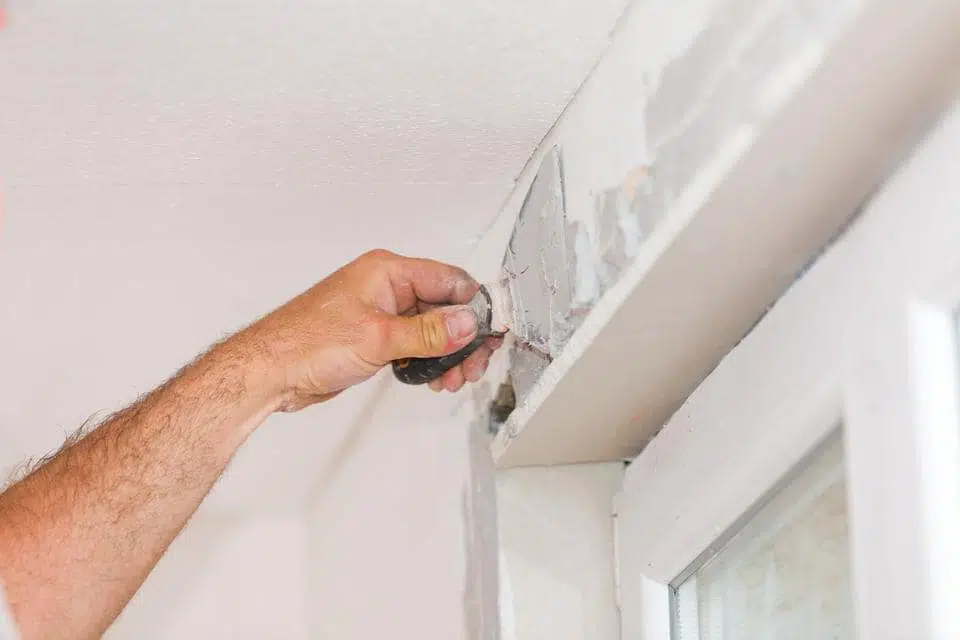Drywall Setup Made Easy: Tips for Perfect Outcomes
Drywall installation is usually perceived as a daunting job, yet with the right technique and knowledge, it can end up being a manageable undertaking. Grasping techniques for cutting, hanging, and ending up drywall can considerably influence the outcome.
Selecting the Right Products
Selecting the proper products for drywall installment is crucial to accomplishing a long lasting and cosmetically pleasing coating. drywall fort worth. The main element, drywall sheets, commonly come in numerous densities, with 1/2-inch sheets being conventional for indoor wall surfaces. For locations requiring added dampness resistance, such as kitchens or restrooms, think about making use of environment-friendly board or concrete board, which are specifically created to hold up against humidity

Preparing the Setup Area
Before beginning the drywall installation procedure, it is important to prepare the installation area thoroughly. A clean work area lessens the danger of damages to existing items and permits for effective movement during installation.
Following, inspect the wall surfaces and ceiling for any imperfections, such as cracks, openings, or mold and mildew. Address these concerns beforehand; patch any type of problems and permit enough time for repair services to completely dry. Additionally, make sure that electrical outlets, switches, and plumbing are properly placed and accounted for, as this will influence drywall positioning.
Take into consideration the environmental problems. A steady temperature and humidity level are important for optimal attachment and performance of the drywall materials. If required, make use of a dehumidifier or heating unit to produce suitable problems.
Trimming and Hanging Drywall
The secret to efficient drywall installation lies in the exact cutting and dangling of the panels. Begin by measuring the space accurately, considering any obstructions such as electrical outlets or windows. Make use of a straight side and an energy blade to rack up the drywall along your dimensions, after that snap it along the racked up line for a clean break. For more elaborate cuts, such as around outlets, a drywall saw can be made use of for precision.

Always function from the top down and delegated right, making sure that you keep a staggered pattern to improve security. Appropriately hanging the drywall establishes the structure for a smooth finish, eventually leading to premium lead to your drywall job.
Taping and Mudding Techniques
While appropriate cutting and dangling of drywall sets the stage, the next important action entails understanding taping and mudding techniques to make certain a seamless surface. Insulation is important for enhancing joints and protecting against splits; it entails embedding tape into the applied joint substance (mud) Beginning with a top quality fiberglass or paper tape, applying the tape over the joint and pressing it right into the damp mud using a taping knife, making sure no air bubbles continue to be.
Once the tape remains in area, apply a thin layer of joint compound over the tape, feathering the edges to produce a smooth shift to the drywall surface. Enable this layer to completely dry totally before sanding it gently check to eliminate flaws. Repeat this procedure, applying additional layers of mud as essential-- usually 2 to 3 layers-- while progressively broadening the application area with each layer to accomplish a smooth look.
After the final coat dries, sand the surface with a fine-grit sandpaper until smooth. drywall contractor. Bear in mind to use a mask during sanding to stay clear of inhaling dirt particles. Mastering these taping and mudding techniques is important for achieving a professional-quality coating in your drywall setup
Completing Touches for Excellence
Achieving a remarkable drywall installation goes beyond taping and mudding; it culminates in the completing touches that boost the overall look. These final steps are essential in guaranteeing a professional-grade coating that boosts the looks of your area.
Begin by fining sand the dried joint substance to develop a smooth surface area. Use a fine-grit sandpaper and a fining sand block or pole sander for optimum control. Pay particular attention to edges browse around this site and sides, as these locations have a tendency to require more careful job. After fining sand, wipe down the walls with you can try these out a damp fabric to eliminate any type of dust fragments, guaranteeing a tidy surface for painting.
Next, use a guide particularly developed for drywall. This action is important, as it aids seal the joint compound and provides a consistent base for the overcoat. When the primer dries out, inspect for any type of imperfections, and repair as required.
Verdict
In verdict, successful drywall installment pivots on the careful selection of products, extensive preparation of the installment location, and accurate execution of cutting and hanging strategies. Mastery of taping and mudding procedures is necessary for accomplishing a smooth coating.
Drywall setup is frequently perceived as a challenging task, yet with the appropriate strategy and expertise, it can become a workable venture.Picking the suitable products for drywall setup is important to attaining a durable and cosmetically pleasing finish.Prior to starting the drywall installment procedure, it is essential to prepare the installment area thoroughly. Grasping these taping and mudding techniques is vital for accomplishing a professional-quality surface in your drywall installment.
In conclusion, successful drywall setup pivots on the mindful choice of materials, detailed prep work of the installment location, and precise execution of cutting and hanging methods.
Comments on “Budget Friendly Drywall Repair Options for Your Fort Worth Property”